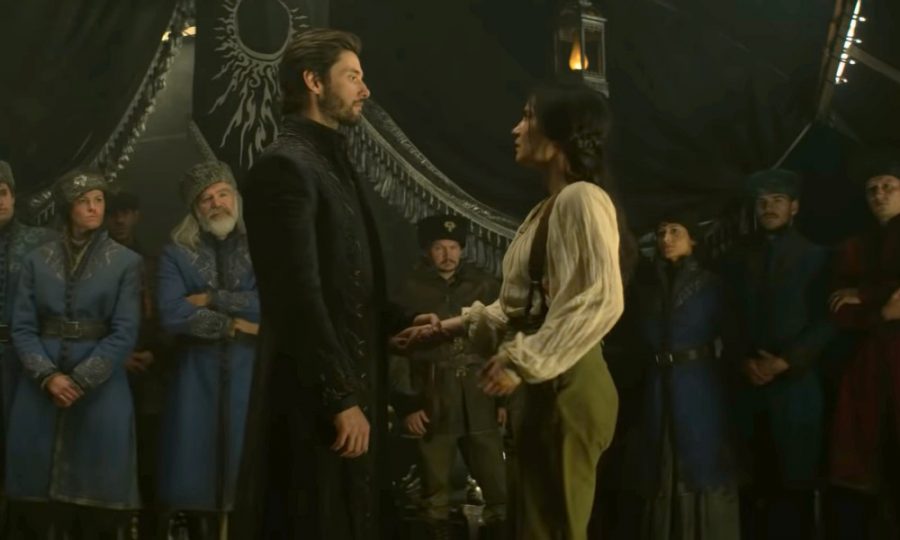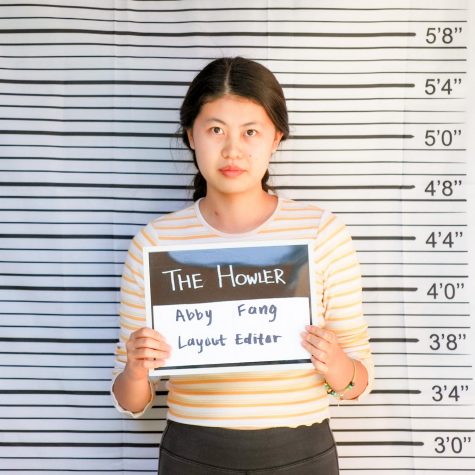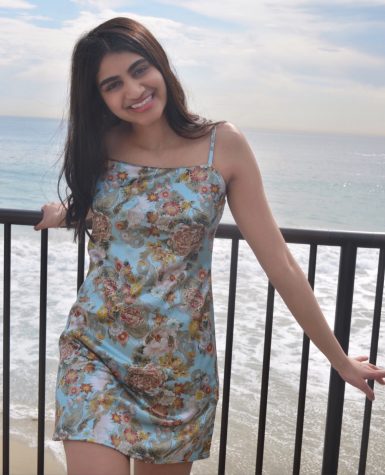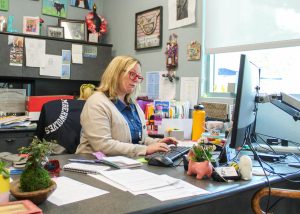Illuminating “Shadow and Bone”: Sitting down with Co-Executive Producer Shelley Meals
“You and I are going to change the world”: Alina meets the Darkling (played by Ben Barnes) for the first time.
May 26, 2021
As one of Netflix’s most popular new releases, “Shadow and Bone” is a fantasy show adapted from Leigh Bardugo’s “Six of Crows” and “Shadow and Bone” book series. Both are set in the same fantasy universe, where a country called Ravka is split in two by the Fold—an expanse of darkness containing vicious creatures that can only be driven away by the mythical Sun Summoner. The show revolves around the stories of Alina Starkov (Jessie Mei Li) and Kaz Brekker (Freddy Carter) and his crew. Here is a deep-dive into all the stories behind the scenes with writer and co-executive producer Shelley Meals.
Warning: spoilers below.
The Howler: How did you first get into screenwriting?
Shelley Meals: When my mom tried to book movies and shows, she was told she wasn’t black enough, which basically meant she didn’t meet the stereotypes they wanted for black people. When I would watch TV as a kid, it never seemed to reflect my reality. It was all stereotyped. So it was natural to me that I would go into writing too. I ended up going to film school at USC, and went on to help write shows like “Fresh Prince of Bel Air.” Something worth noting about this industry is that people like to put you in boxes. For many years, my box was medical shows, but fantasy was always my thing.
TH: Why was the decision made to combine Bardugo’s separate “Six of Crows” and “Shadow and Bone” series into one show, causing changes such as altering the timeline of the stories? For these changes and some others, how much was Bardugo consulted for them?
SM: That was the brilliant idea of Eric Heisserer, who’s our showrunner—he’s the one that developed the show with Netflix and Bardugo. I’m not sure exactly where he got the idea, but it was a great idea to do it. I think he wanted to explore all sides of the world, not just the Alina side with “Shadow and Bone.” Bardugo has been involved the whole step of the way—she created the world and the characters, and we brought her into the writers’ room often to bounce ideas off of her, get her feedback and listen to her ideas.
TH: Was there a reason the original “Shadow and Bone” series plot was mainly consistent with the books but not the role of the Crows?
SM: If you look at the books, “Six of Crows” happens after the whole “Shadow and Bone” series, so it didn’t make sense for those characters to be in that place that they are in “Six of Crows” if we’re telling the first part of the story in “Shadow and Bone.” That’s how we knew we had to come up with a prequel, in a sense, for the Crows.
TH: A lot of people were huge fans of Bardugo’s books even before this and were really excited when Netflix announced this show—how did it feel to write and produce this show given the high expectations of some?
SM: We definitely all felt the pressure from the fans. I think that also though, Bardugo was very clear that we needed to be free to make it work for television, and sometimes a direct adaptation isn’t the thing that works best for a show where you need a propulsive drive from episode to episode. Everyone on the writing staff were huge fans of the books so we wanted to do honor to them.
TH: We saw that you did the teleplay for the “The Heart is an Arrow” episode—can you quickly describe any artistic choices you decided to make that you thought might be important?
SM: There are a number of reasons why I really wanted to do that episode. I loved the Malina of it all, and I think that in the writers’ room we really wanted to build Mal and just give him more dimension than he had in the book, because Bardugo just didn’t have the space to do that and a lot of book fans really hated Mal. We felt that we could build a Mal that did him a little more justice, as a choice. A scene that really spoke to me—I’m a mom too, I’ve got two girls—is the part where Alina starts to confess to Mal about what happened with the Darkling in the Little Palace, and he tells her she doesn’t owe him an explanation. I’m like, “That’s what I want to see!” It’s like she’s her own person, she makes her own choices, he doesn’t control her and she doesn’t owe him an explanation. I think that that’s powerful. Malina, I love them!
TH: It was super empowering as a South Asian teenager to see Amita Suman on screen, playing a role in which she isn’t just checking a minority box or portraying a stereotypical version of South Asians. What was the casting process like for minority characters and how did you ensure fair representation of these characters?
SM: I’ve been writing for television for a really long time, and obviously before that I was watching television for a very long time. I felt like you and I felt like I didn’t see people that looked like me represented on a screen. Usually in fantasy, we weren’t there at all or we were killed immediately. I’ve got two biracial girls now and part of the reason I was attracted to this material in the first place is because of the cast and the diversity in the cast. If you look at the main six characters, neither of the women are white. It was really important to me to have that portrayal. There were a number of us in the writers’ room that identified different ways and it was always a priority, so in terms of casting we would use our voice. But there wasn’t any attempt to whitewash anything. I think we found such a star in Suman. It was difficult to cast and there were so many tapes, but for so many of the roles, and Suman’s one of them, the first time I saw her tape I was like, “That’s it, that’s got to be Inej.” She just had that special energy. She’s tiny but powerful.
TH: We did hear that the stunt double for Suman was a white person wearing brownface. Do you have any general comment on this controversy as to why the decision was made to cast them instead of a brown person?
SM: That is not a writer’s job or anything I had any control over. It was very, very unfortunate that that happened, it should not have happened, and I’m sure it will not happen again. That’s a bigger Netflix conversation.
TH: The way Bardugo wrote the characters is really layered and there’s such a special relationship between each and every one of the characters. What was the collaboration process like to make sure all of these feelings and nuances were reflected on-screen?
SM: The actors really did their homework so they understand all of the history of their characters. They also all had access to Bardugo so they could all have conversations with Bardugo to understand their backstories even deeper than what they might be in the books. In terms of the show, it was hard because you have to walk a fine line. You’ve got people who’ve read all the books and people who don’t know anything, so it’s hard sometimes to figure out how much you want to tell. I’ve had people who’ve seen the season tell me that they don’t understand why Kaz has an issue with touch, but I think that’s okay because we just haven’t told that story yet. It’s not over, hopefully, if we get a season two. Those are interesting questions to have moving forward. We can’t answer everything in eight episodes.
TH: The show also incorporated a new character that instantly became a fan-favorite—how did the idea for Milo the goat begin?
SM: That goat was Daegan Fryklind’s idea. She was trying to come up with something for Jesper in episode 3. She loves animals. Daegan has a dog named Milo who everyone fell in love with, and he was suffering from cancer. We decided to name the goat Milo in his remembrance. That way, he can live on forever through the character.
TH: The writers’ room has been mentioned several times so far—what does the process look like when everyone is making these decisions for the show?
SM: Everybody doesn’t agree all the time, and I think that’s good. Sometimes, really interesting things happen when people don’t agree with each other. It’s akin to a debate. There isn’t any animosity involved, but as you unpack the scene you discover new things. Don’t get me wrong, there have been other writers’ rooms in which that hasn’t been true. But in this one, our discussions lead to some really interesting ideas.
TH: One of the most endearing things about the show is the actors’ chemistry with one another, and how close all the cast members are. How did this bond form so quickly after everyone was casted?
SM: Part of that I think is just luck. You do chemistry tests, which are when you’re auditioning actors and you have them come in and read the scenes with other actors that might be cast alongside them—that’s a common practice and we certainly did that. But I think that we honestly just got really lucky in that our cast just really genuinely clicked right away. I mean they’re all really great people, so nice, so down-to-earth and so committed to their craft, and also fans of the books and the characters. I take no credit for that. They’re amazing.
TH: If you were involved in it, can you describe what the general auditioning and casting process was like for Shadow and Bone?
SM: It didn’t look terribly different from most shows. We cast a really wide net looking for people all over the world, we looked at tapes from everywhere and just narrowed it down from there. Once we got close on a few people, we had chemistry auditions to see how people worked with each other, but we didn’t do anything terribly different than a typical show. Although I would say maybe the net was wider in that it was a worldwide net that we cast.
TH: How did shooting and production adhere to COVID-19 guidelines or how was it changed by COVID-19?
SM: We actually did not shoot during COVID-19, we wrapped a week before everything shut down. What slowed us down was post-production, so initially the show most likely would have dropped a lot sooner, but COVID-19 slowed down the visual effects, the editing and that side of things.
TH: The Grishaverse is obviously very developed in Bardugo’s books already—what was the costume design process like for the show? How did you choose to both replicate it and change it for the show?
SM: Our costume designer is named Wendy Partridge and she’s just phenomenal. She read the books as well and she came to Heisserer with a number of ideas and sketches that were just gorgeous from the beginning. So it was really collaborative between Heisserer, Partridge and Bardugo to make the choices on how strict we were going to be to what was in the books. Everybody was there to throw their creative ideas to the table and figure out what worked best. Partridge just worked tirelessly with her team and they did such an amazing job. There’s so much detail, and a lot of it you don’t even see, they’re so tiny.
TH: If you were involved in this part, what editing techniques were used to create the Fold, Alina’s light, etc.?
SM: I wasn’t involved in the editing but I was on set with the VFX people who created that with Heisserer. We had a really amazing team, we had the same team that did “Game of Thrones.” Ted Ray was the effects supervisor and he was very creative. We were creating something that hadn’t been seen before, I mean there was no Fold. It was a whole new thing, so there were a lot of conversations about exactly what it would look like, what it would feel like and what the texture was like. That and sound design goes a long way to creating that effect and how you feel when you go into the Fold and when you see Alina’s light. For the most part, it was green screen or very dark on set, so we had really amazing actors because they did not have anything to look at.
TH: What lessons did you learn or take away from producing this show you might apply in the future, and what were some memories that really stood out to you?
SM: It’s very cold in Budapest. I’ve been doing this a long time and it’s different from other shows because we were all away from home. Sometimes I’ve worked on shows that shoot in Vancouver or Toronto, but that’s so close to home and you can fly home for the weekends and everyone speaks the same language. This way, it almost feels like camp. We were this little community because we didn’t speak Hungarian, although I will say Jessie (Mei Li) learned. We made this little family with each other, which was really fun.
TH: If there’s a season two, will it adhere to how Bardugo wrote the next books or will the show take a different spin on it?
SM: No way to know, they’ve got to pick it up! People have to keep watching!
TH: How would you describe this show to people who have never watched it?
SM: I think it’s a mistake for a show to try to be all things for all people. This show speaks to the people it needs to speak to. If it’s not your thing, I completely respect that. But if you love fantasy, drama and romance, and you want to see a diverse cast that reflects the real world, then this is the show for you.



![AAAAAND ANOTHER THING: [CENSORED] [REDACTED] [BABY SCREAMING] [SIRENS] [SILENCE].](https://thehowleronline.org/wp-content/uploads/2025/06/lucy-1200x800.jpg)


















































![AAAAAND ANOTHER THING: [CENSORED] [REDACTED] [BABY SCREAMING] [SIRENS] [SILENCE].](https://thehowleronline.org/wp-content/uploads/2025/06/lucy-300x200.jpg)



